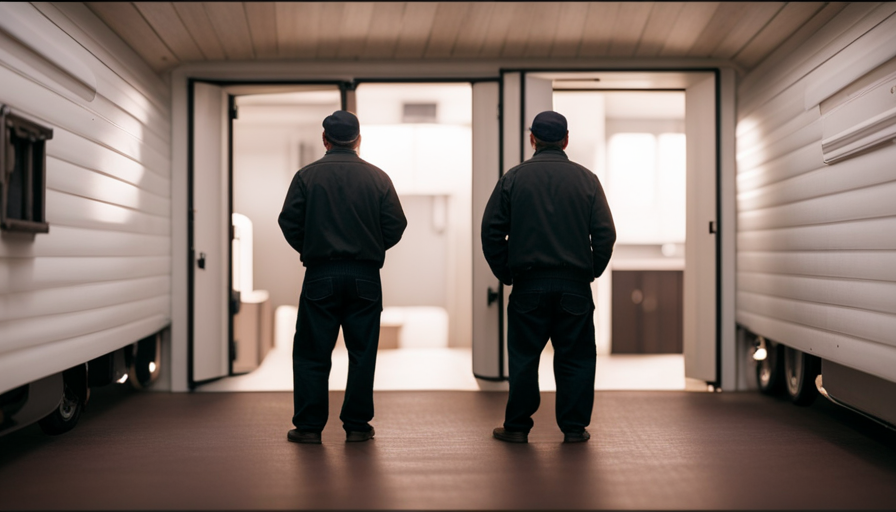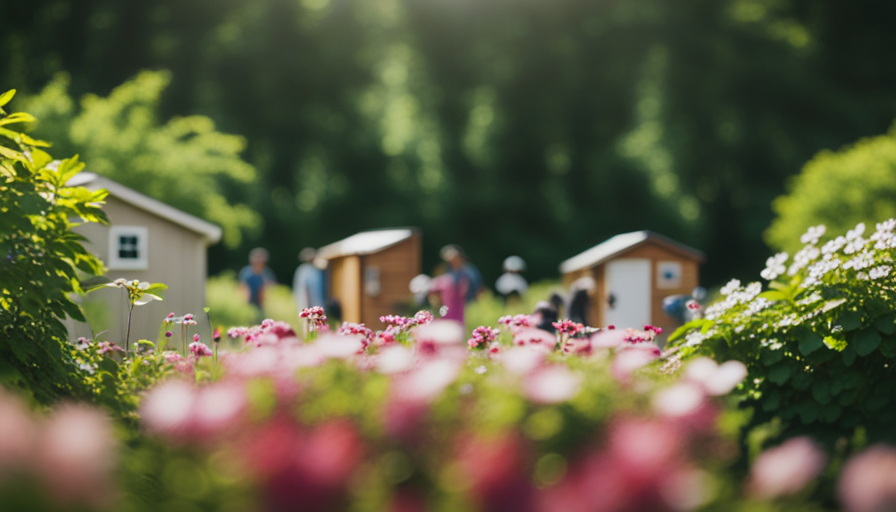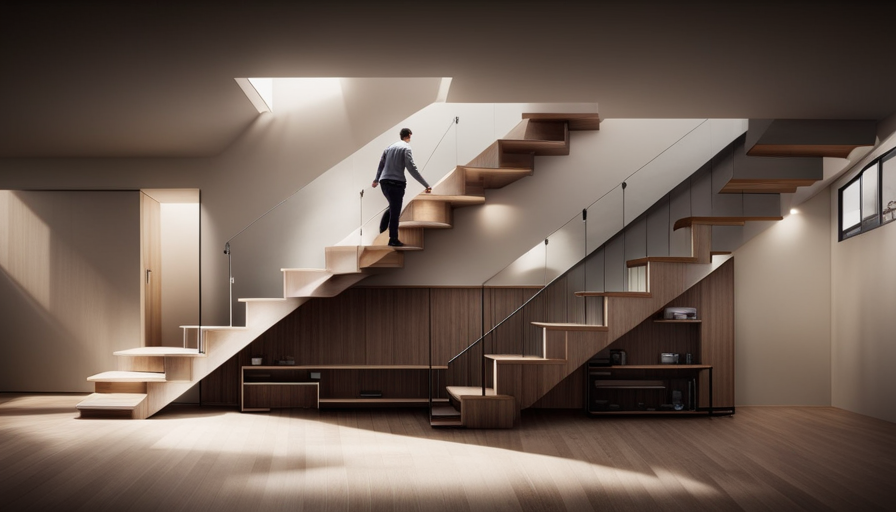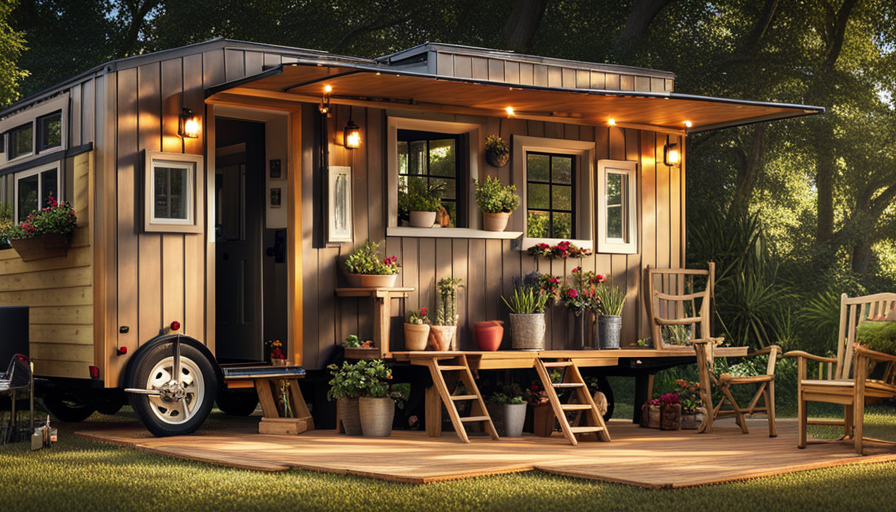Get ready for an incredible revelation! Prepare yourself, as I am about to reveal the surprising truth about the ceilings in tiny, mobile homes. Brace yourself for a complete shift in your perspective, as these small dwellings are anything but ordinary. Despite their size, the ceilings in these movable houses can reach impressive heights, defying all expectations and redefining the idea of living in a confined space.
In this article, I will take you on a journey into the world of tiny houses on wheels, where the sky’s the limit when it comes to ceiling height. We’ll explore the average heights you can expect, the factors that influence these heights, and the benefits of reaching for the stars with your tiny house’s ceiling. I’ll even share design tips to create the illusion of even higher ceilings and showcase real-life examples of tiny houses with varying heights.
So, fasten your seatbelts and get ready to be blown away by the soaring heights of ceilings in tiny houses on wheels. Let’s dive in and discover the untapped potential of these compact yet spacious homes.
Key Takeaways
- Higher ceilings in tiny houses on wheels allow for more storage options and innovative solutions.
- Taller ceilings create a more spacious and open feeling, alleviating claustrophobia.
- Better ventilation and natural light are possible with taller ceilings.
- Factors affecting ceiling height include design choices, trailer height, and transportation regulations.
Importance of Ceiling Height in Tiny Houses on Wheels
When it comes to tiny houses on wheels, the importance of ceiling height can’t be overstated. Maximizing storage is crucial in these small spaces, and having a higher ceiling allows for more creative solutions.
With limited floor space, utilizing vertical space becomes essential, and taller ceilings provide the room needed for innovative storage ideas. From built-in shelving units to lofted beds, higher ceilings open up a world of possibilities.
Not only does a higher ceiling provide more storage options, but it also creates a more spacious and open feeling inside the tiny house. It helps to alleviate any feelings of claustrophobia that can arise in such tight quarters. Additionally, a taller ceiling allows for better ventilation and natural light, making the space feel brighter and more inviting.
While there is no standard for average ceiling heights in tiny houses on wheels, most builders aim for a minimum height of 6 feet 4 inches. However, some tiny houses may have ceilings as high as 8 or 9 feet, depending on the design and preferences of the owner. These taller ceilings provide even more flexibility for storage and design choices.
With the importance of ceiling height in mind, let’s explore the average ceiling heights in tiny houses on wheels and how they impact the overall living experience.
Average Ceiling Heights in Tiny Houses on Wheels
When it comes to tiny houses on wheels, the average ceiling height is an important factor to consider. Standard ceiling heights in these homes typically range from 6 to 8 feet, depending on the design and layout. However, maximizing ceiling height can be achieved through thoughtful design considerations. This includes incorporating vaulted ceilings, utilizing loft spaces, and strategic placement of windows to create an illusion of greater height.
Standard Ceiling Heights
The standard ceiling height in most tiny houses on wheels is around 6.5 feet, providing a cozy yet comfortable living space. Adequate ventilation is essential in tiny houses to maintain air quality, and the standard ceiling height allows for the installation of ceiling fans or vents to promote airflow. Additionally, a higher ceiling can create a more spacious and open feeling in the tiny house, which can be appealing to potential buyers and increase the resale value. On the other hand, a low ceiling height may make the space feel cramped and may deter buyers in the future. Maximizing the ceiling height with design considerations can help create the illusion of a larger space, such as using light colors, mirrors, and strategic lighting.
Maximizing Ceiling Height with Design Considerations
To make the most of your cozy space, consider incorporating design elements that maximize the illusion of a larger area. This can be achieved by using light colors, mirrors, and strategic lighting.
Another important consideration is maximizing storage space. In a tiny house on wheels, every inch counts. So, utilizing clever storage solutions like built-in shelving, under-bed storage, and multi-functional furniture can help to keep your space organized and clutter-free.
Additionally, incorporating natural light is crucial in creating a sense of openness and spaciousness. Skylights, large windows, and glass doors can flood your tiny house with natural light, making it feel more expansive.
By combining these design considerations, you can create a tiny house on wheels that feels bigger and more comfortable than its actual size suggests.
Moving on to the next section about factors affecting ceiling height in tiny houses on wheels…
Factors Affecting Ceiling Height in Tiny Houses on Wheels
Factors such as design choices, trailer height, and transportation regulations all impact the ceiling height in tiny houses on wheels. When designing a tiny house, it’s important to consider these factors in order to maximize the ceiling height and create a comfortable living space.
Design choices: The layout and design of the tiny house can greatly affect the ceiling height. By opting for an open floor plan and utilizing vertical space efficiently, it’s possible to increase the height of the ceilings. Additionally, incorporating large windows can help bring in natural light and create the illusion of a higher ceiling.
Trailer height: The height of the trailer itself plays a significant role in determining the ceiling height. Some trailers have a higher deck height, allowing for taller ceilings in the tiny house. It’s important to consider this factor when selecting a trailer for your tiny house on wheels.
Transportation regulations: Each state has its own regulations regarding the maximum height of a structure that can be transported on the road. These regulations can impact the ceiling height of a tiny house on wheels. It’s essential to be aware of these regulations and ensure that the height of your tiny house complies with them.
By considering these factors, it’s possible to maximize the ceiling height in a tiny house on wheels, which has numerous benefits such as allowing for more natural light and improving air circulation. Higher ceilings can create a more spacious and comfortable living environment.
Benefits of Higher Ceilings in Tiny Houses on Wheels
When it comes to tiny houses on wheels, the height of the ceilings is an important consideration. In my previous discussion, I explored the various factors that can affect the ceiling height in these small dwellings.
Now, I want to delve into the benefits of having higher ceilings in tiny houses on wheels.
One of the advantages of higher ceilings is that they create a sense of openness and spaciousness. In a tiny house where every square inch counts, designing with limited space in mind is crucial. By having higher ceilings, you can visually expand the living area and make it feel less cramped.
Another benefit of higher ceilings is the ability to optimize natural light. Natural light is a precious resource in a tiny house, as it can make the space feel brighter and more inviting. With higher ceilings, you can install larger windows or skylights, allowing more sunlight to flood into the interior. This not only enhances the aesthetics of the space but also reduces the need for artificial lighting during the day.
In the next section, I will share some design tips that can help create the illusion of higher ceilings in tiny houses on wheels.
Design Tips to Create the Illusion of Higher Ceilings
One effective way to achieve a sense of spaciousness in compact mobile homes is by implementing clever design techniques. Design tricks and lighting techniques can create the illusion of higher ceilings, making the tiny house on wheels feel larger and more open.
To start, using vertical lines in your design can draw the eye upwards, making the space appear taller. This can be achieved through the use of tall curtains or vertical stripes on walls. Another design tip is to choose furniture with low profiles, as bulky furniture can make the ceiling feel lower. Opting for furniture with slim legs or even floating furniture can give the impression of more floor space, which in turn can make the ceiling seem higher.
In addition to design tricks, lighting techniques can also play a role in creating the illusion of higher ceilings. By using recessed lighting or pendant lights that hang down from the ceiling, you can draw attention upwards and make the ceiling appear higher. Additionally, using natural light and strategically placed mirrors can help bounce light around the space, making it feel brighter and more open.
Considering these design tips and lighting techniques can greatly enhance the sense of spaciousness in a tiny house on wheels. Next, we will explore considerations for tall individuals in these compact spaces.
Considerations for Tall Individuals in Tiny Houses on Wheels
If you’re a tall individual stepping into a mobile home, you may find yourself feeling cramped and restricted in your own personal space. Designing for comfort becomes crucial in tiny houses on wheels to accommodate individuals of all heights. Here are some considerations for tall individuals in tiny houses on wheels:
-
Ceiling height: Look for tiny houses with higher ceilings, around 9 feet or more, to provide a greater sense of spaciousness and prevent the feeling of being closed in.
-
Loft design: Opt for a tiny house with a loft that has a higher ceiling height, allowing for more headroom while sleeping or moving around.
-
Doorway height: Ensure that the doorways in the tiny house are tall enough to prevent frequent head bumps and provide easy access for taller individuals.
-
Creative storage solutions: Make use of clever storage solutions, such as built-in shelves or cabinets that extend higher up the walls, to maximize space and keep belongings organized.
By considering these factors, tall individuals can design and customize their tiny house on wheels to suit their needs and preferences.
In the next section, we will explore case studies of different tiny houses on wheels with varying ceiling heights, providing examples of how each design choice affects the overall living experience.
Case Studies: Examples of Tiny Houses on Wheels with Different Ceiling Heights
Imagine stepping into a mobile abode where the sky seems to have descended upon its compact space, allowing you to revel in an expansive and liberating sanctuary. In this section, we will explore case studies of tiny houses on wheels with different ceiling heights, highlighting how these variations can impact the overall living experience.
One example of a tiny house on wheels with a higher ceiling is the ‘Skyline Retreat.’ With a ceiling height of 10 feet, this tiny house offers a sense of openness and spaciousness. The high ceiling allows for taller furniture, such as bookshelves and cabinets, maximizing storage options. Additionally, the extra height creates opportunities for creative lighting solutions, such as pendant lights or hanging plants, which add a touch of elegance to the space.
On the other end of the spectrum, the ‘Cozy Haven’ boasts a lower ceiling height of 6 feet. While it may seem restrictive, this tiny house showcases how a lower ceiling can create a cozy and intimate atmosphere. By utilizing built-in storage solutions and strategic furniture placement, the ‘Cozy Haven’ maximizes storage without compromising on functionality.
These case studies demonstrate that there is no one-size-fits-all approach when it comes to ceiling heights in tiny houses on wheels. The key is to find a balance between maximizing storage and creating a comfortable living space. In the next section, we will explore tips for maximizing vertical space in tiny houses on wheels, further enhancing the utilization of these unique abodes.
Tips for Maximizing Vertical Space in Tiny Houses on Wheels
Get ready to make the most of your compact mobile dwelling by discovering top tips for maximizing vertical space in your tiny rolling sanctuary.
In a tiny house on wheels, every inch counts, so it’s important to utilize the vertical space efficiently. One of the best ways to maximize storage in your tiny house is to think vertically. Install high shelves or cabinets that reach all the way to the ceiling. This allows you to store items that are used less frequently up high, while keeping everyday essentials within easy reach.
Another great option is to utilize the space under your loft or bed by installing drawers or bins for additional storage.
When it comes to furniture in a tiny house on wheels, it’s important to think outside the box. Look for multi-functional pieces that can serve multiple purposes. For example, a sofa that can be converted into a bed or a dining table that can double as a workspace. Consider installing wall-mounted foldable tables or desks that can be folded up when not in use.
Incorporating creative furniture solutions and maximizing storage will help you make the most of your vertical space in a tiny house on wheels. By utilizing these tips, you can create a functional and organized living space that feels spacious despite its compact size.
Now, let’s transition into the next section about safety considerations for ceiling heights in tiny houses on wheels.
Safety Considerations for Ceiling Heights in Tiny Houses on Wheels
When designing small spaces like tiny houses on wheels, it’s crucial to consider safety regulations, especially when it comes to ceiling heights. This is the current subtopic, and I’ll now delve into the various safety considerations that one must keep in mind.
First and foremost, it’s important to check the local building codes and regulations regarding ceiling heights for tiny houses on wheels. These regulations are put in place to ensure the safety and well-being of the occupants. Adhering to these guidelines will prevent any potential accidents or hazards.
Additionally, it’s essential to consider the activities that’ll take place inside the tiny house. If you plan on incorporating a loft or a sleeping area in the upper portion of the house, you must ensure that there’s enough headroom for comfortable movement. Lack of headroom can lead to injuries and discomfort.
Furthermore, proper ventilation is crucial in small spaces to prevent the buildup of moisture and mold. A higher ceiling height allows for better airflow and ventilation, promoting a healthier living environment.
When designing a tiny house on wheels, safety considerations for ceiling heights play a significant role. By following local regulations, considering the activities that’ll take place inside, and ensuring proper ventilation, you can create a safe and comfortable living space.
Transitioning into the subsequent section about "conclusion: finding the right ceiling height for your tiny house on wheels," it’s important to understand the factors that influence this decision.
Conclusion: Finding the Right Ceiling Height for Your Tiny House on Wheels
To determine the ideal height for your compact mobile dwelling, consider that the average human adult requires approximately 7-8 hours of sleep each night, allowing for comfortable movement and preventing potential accidents.
When it comes to tiny houses on wheels, finding the right ceiling height is crucial for creating a safe and comfortable living space. But it’s not just about safety; the ceiling height also impacts the overall functionality and aesthetic appeal of your tiny home.
To maximize natural light in your tiny house, it’s important to have a ceiling height that allows for large windows or skylights. This not only brightens up the space but also creates a greater sense of openness and connection to the outdoors.
Additionally, a higher ceiling can make your tiny house feel more spacious and less claustrophobic.
Another important consideration is the impact of ceiling height on heating and cooling. A taller ceiling can make it more challenging to maintain a comfortable temperature, as the air has more space to circulate. On the other hand, a lower ceiling can help to trap heat during the colder months, reducing the need for excessive heating.
Finding the right ceiling height for your tiny house on wheels is a balancing act between safety, functionality, and aesthetic appeal. Consider factors such as maximizing natural light and the impact on heating and cooling when making your decision. Remember, your tiny home should be a reflection of your lifestyle and personal preferences, so take the time to find the perfect fit.
- Maximize natural light
- Create a sense of spaciousness
- Consider heating and cooling efficiency
- Reflect your personal preferences
Frequently Asked Questions
How can I maximize vertical space in my tiny house on wheels?
To maximize vertical space in my tiny house on wheels, I can focus on two key areas:
-
Maximizing storage: I can invest in space-saving furniture like storage ottomans or loft beds with built-in drawers.
-
Utilizing the loft space: This area can provide extra storage or even serve as a functional sleeping area.
By incorporating these strategies, I can make the most of the limited space in my tiny house on wheels.
What are some design tips to create the illusion of higher ceilings in a tiny house on wheels?
Creating the illusion of higher ceilings in a tiny house on wheels can be achieved through several design tips. Firstly, utilizing vertical lines in the interior decor can create an optical illusion of height.
Additionally, using light colors on the walls and ceiling can enhance natural light and make the space feel more open.
Incorporating strategically placed mirrors can also reflect light and give the impression of a larger space.
These design techniques can help maximize the perceived height in a tiny house on wheels.
Are there any safety considerations I should keep in mind when it comes to ceiling heights in tiny houses on wheels?
When it comes to safety precautions in tiny houses on wheels, ceiling height is a crucial factor to consider. Not only does it affect the overall comfort and livability of the space, but it also has an impact on ventilation.
Adequate ceiling height ensures proper airflow and prevents the accumulation of moisture or stagnant air. Additionally, it’s important to ensure that the ceiling is sturdy and securely installed to avoid any potential hazards or accidents.
Can you provide some case studies or examples of tiny houses on wheels with different ceiling heights?
When it comes to tiny houses on wheels, there are various ceiling height options available. Low ceiling heights can provide a cozy and intimate atmosphere, which some people prefer. Additionally, low ceilings can contribute to better energy efficiency by reducing the volume of air that needs to be heated or cooled. This can result in lower energy consumption and cost savings.
However, it’s important to consider personal preferences and the potential impact on comfort and functionality before deciding on a specific ceiling height.
What are the considerations for tall individuals when it comes to living in a tiny house on wheels?
Considerations for tall individuals when living in a tiny house on wheels include the need for adequate headroom and storage solutions. Since the ceiling height may be limited, it’s important to ensure the living arrangements are comfortable and spacious enough.
This can be achieved by designing the layout to maximize vertical space and choosing furniture that’s compact yet functional. Additionally, creative storage solutions such as built-in cabinets and loft areas can help optimize the limited space available.
Conclusion
In conclusion, finding the right ceiling height for your tiny house on wheels is crucial. It’s like reaching for the stars, where the height of the ceiling determines how far you can dream and how much space you have to grow.
From the practicality of everyday living to the psychological impact of a spacious atmosphere, higher ceilings offer numerous benefits. By maximizing vertical space and considering safety considerations, you can create a tiny house that not only meets your needs but also inspires your imagination.
So, aim high and let your tiny house on wheels become a symbol of limitless possibilities.
Hi, I’m Emma. I’m the Editor in Chief of Tiny House 43, a blog all about tiny houses. While tree houses are often associated with childhood, they can be the perfect adult retreat. They offer a cozy space to relax and unwind, surrounded by nature. And since they’re typically built on stilts or raised platforms, they offer stunning views that traditional homes simply can’t match. If you’re looking for a unique and romantic getaway, a tree house tiny house might just be the perfect option.










